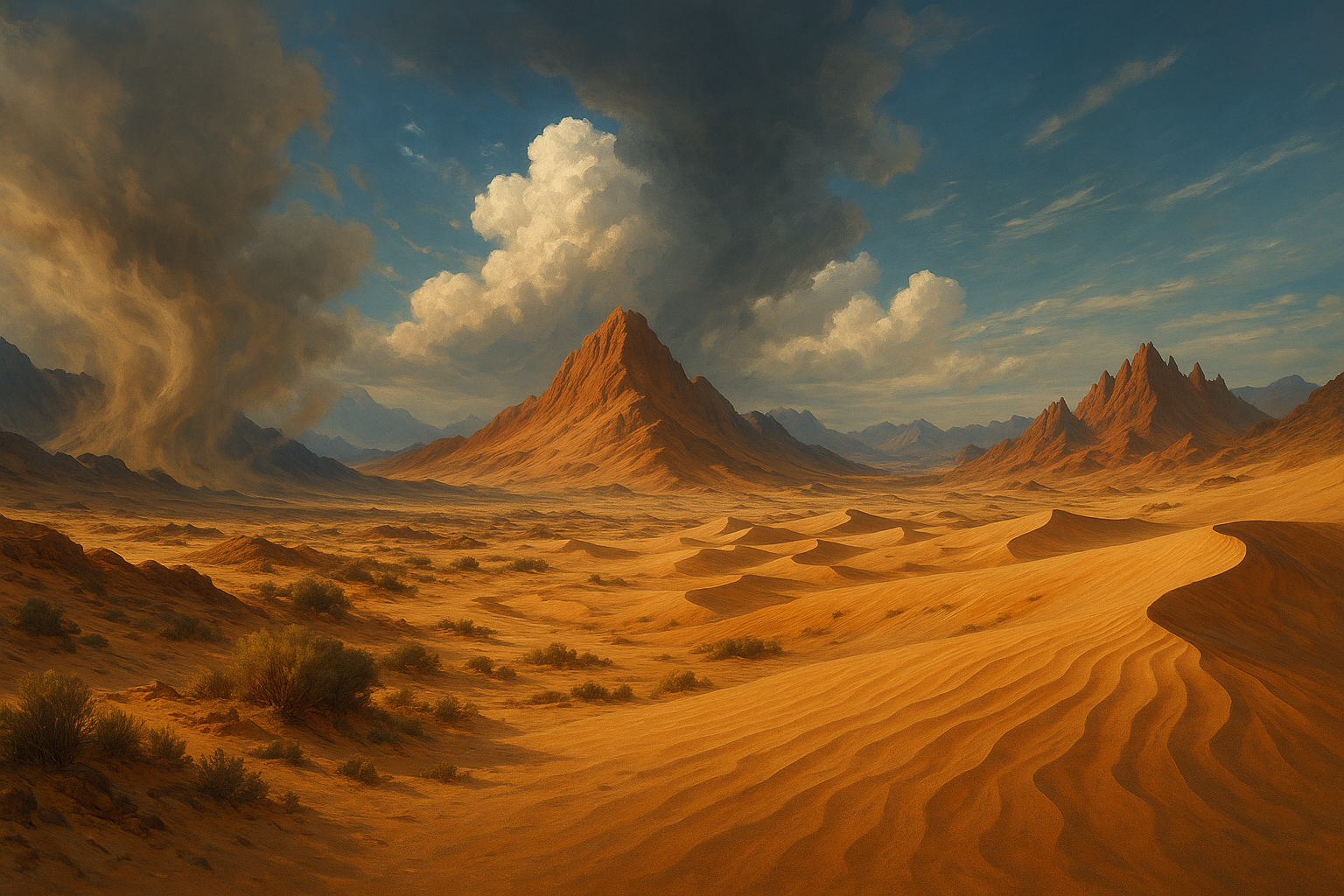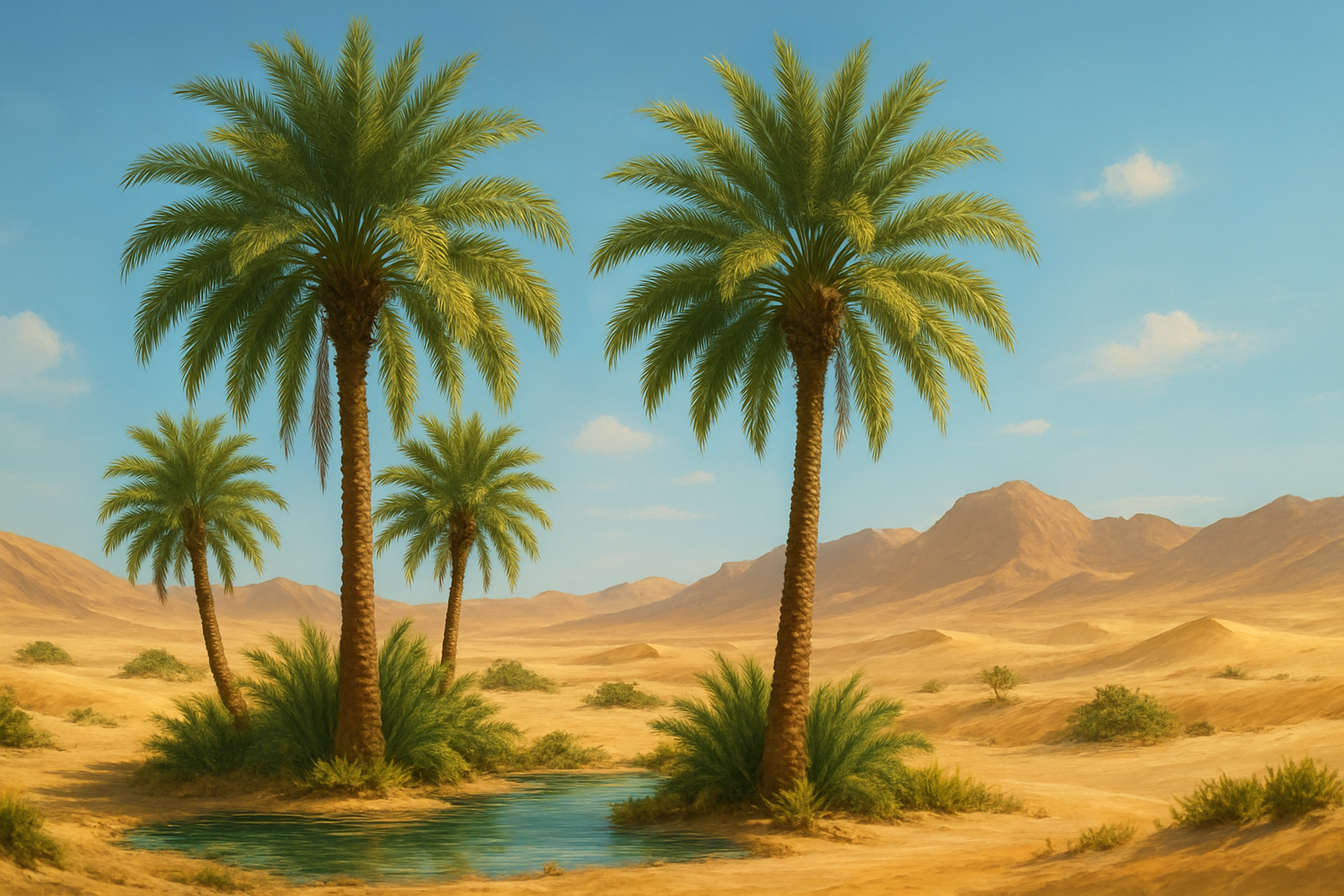Eastern Arid Basin
The Eastern Arid Basin lies on the far side of the Ashspire Mountains, where fertile lands give way to an unforgiving landscape of sun-scorched plains, rocky plateaus, and wind-carved deserts. This region is shaped by the relentless heat of the sun and the leyline currents that thread beneath the sand, creating an environment that is as magical as it is harsh. Despite its aridity, the basin is home to resilient cultures, thriving trade routes, and wonders that can only exist in a land so intimately tied to the elements.
The people of the Eastern Arid Basin are adapted to survival in extremes. Nomadic clans traverse the dunes with caravans, trading rare goods and knowledge. Walled city-states thrive around the largest oases, their spires rising like mirages from the sands. These cultures value endurance, wisdom, and the mastery of fire and light magic, which they use both for survival and as symbols of their identity.
Art and architecture reflect the desert’s beauty—ornate stone carvings, vibrant fabrics that mimic the hues of the dunes, and shrines aligned to celestial events.
Geography
The basin stretches across a wide expanse bordered by the Ashspire volcanic ridges to the west and tapering into coastal cliffs and dry savannas toward the east. Rolling dunes dominate the heart of the basin, shifting constantly under the force of seasonal winds. Rocky outcroppings and deep canyons break the monotony of the sands, providing shelter and hiding places for nomadic settlements.
Scattered throughout are oases fed by underground rivers from the mountains, serving as lifelines for both humans and wildlife. Salt flats shimmer under the sun, while petrified forests and sun-bleached ruins stand as remnants of civilizations lost to the desert’s advance.
Ecosystem
The Eastern Arid Basin is far more than endless sand—it is a land of dramatic contrasts, where dry dunes meet rocky scrublands, and rare rivers feed pockets of life. Its ecosystem reflects a desert-savana hybrid, where life is both fragile and astonishingly resilient. Inspired by the diversity found in Indian subcontinental deserts and semi-arid regions, this basin harbors flora and fauna uniquely adapted to survive the extremes of sun, wind, and leyline-charged storms.
The ecosystem thrives around cycles of scarcity and sudden abundance. Short bursts of rain transform dunes into flower-strewn fields overnight, only to wither back to sand in days. Predators migrate with herds, and scavengers rely on the remnants of leyline storms, feeding on the magical fallout.
This delicate balance is easily disturbed. The presence of magic—especially the Sunveil Mirage phenomenon—creates temporary ecosystems where phantom creatures feed alongside real ones, blurring the lines between illusion and reality.
Climate
The Eastern Arid Basin is defined by its harsh, sun-baked climate shaped by the Ashspire Mountains to the west and the dry winds sweeping in from the open plains to the east. These factors create dramatic temperature shifts and an atmosphere where survival demands adaptation.
Temperature
- Daytime: The sun is relentless, driving temperatures to searing highs. The air ripples with heat, and sand surfaces can scorch bare skin.
- Nighttime: After sunset, temperatures plummet rapidly, bringing cold desert winds that force travelers to seek shelter.
- Seasonal Variations: Summers are long and brutal, while winters, though cooler, remain arid and windy.
Rainfall
- Rain is scarce and comes mostly during brief seasonal storms, when violent downpours flood dry riverbeds and carve new channels into the earth.
- These rains are short-lived but transformative, causing dormant seeds to sprout and bringing bursts of life to the desert.
Winds and Storms
- The Basin is notorious for its dust storms and sand-whipping winds.
- These storms can blot out the sun for hours, carry fine particles that infiltrate lungs and equipment, and sometimes mix with leyline energy, creating Burning Whispers, where the wind carries haunting voices.
Magical Weather
- Sunveil Events: When leyline energy surges under intense sunlight, mirages form that seem almost real, altering both the air and the traveler’s perception.
- Glassstorm Strikes: Rare lightning storms fuse the sand into glass, leaving reflective fields that hum faintly with residual power.
Fauna & Flora
Flora
Despite the unforgiving climate, the Basin’s vegetation is surprisingly diverse, clustering around oases, canyons, and mountain-fed riverbeds.- Sunveil Blossoms – Night-blooming flowers with luminous petals that close before dawn. Used in teas and potions for their calming properties.
- Firebloom Cactus – A magical cactus storing volatile energy. When threatened, it releases bursts of flame and smoke.
- Desert Palms – Towering trees near oases, providing shade and sweet fruit that sustains travelers.
- Ironbark Shrubs – Hardy bushes with metallic bark that resists sand erosion. Their leaves are crushed into medicinal poultices by nomads.
- Mirage Reeds – Tall, flexible plants that shimmer in heatwaves, creating the illusion of moving water even where none exists.
Fauna
Life in the Basin has adapted to both heat and scarcity, resulting in creatures that are either swift, armored, or magically attuned.- Sand Gazelles – Agile antelope-like creatures with reflective coats that scatter sunlight. They travel in herds, avoiding predators by outrunning storms.
- Dune Stalkers – Large, reptilian predators that burrow beneath the sand, ambushing prey with sudden strikes. Their scales store heat, allowing them to move even in the cold desert night.
- Sunscale Serpents – Brightly colored snakes that bask in sunlight to energize their venom, which glows faintly when exposed to air.
- Skyhorn Vultures – Gigantic carrion birds circling thermal currents, believed to be omens of death or divine messengers depending on local beliefs.
- Caravan Hounds – Domesticated canines bred by nomads for endurance, capable of running alongside caravans for days.
Natural Resources
Despite its arid climate, the Eastern Arid Basin is rich in rare and valuable resources hidden within its sands, rocky outcrops, and leyline-charged regions. These resources fuel trade, conflict, and the survival of those who know how to harvest them.
Minerals and Metals
- Sunsteel Ore – Found in veins beneath the desert plateaus, this golden-hued metal absorbs heat during the day, becoming nearly unbreakable when forged correctly. It is prized for weapons and ceremonial armor.
- Ashglass – Naturally occurring glass formed when lightning fuses desert sand. It resonates faintly with magical energy, used in enchantments and arcane devices.
- Ember Crystals – Deep within volcanic fissures, these red crystals store elemental fire, valued by mages and artificers.
Plants and Herbal Resources
- Sunveil Blossoms – Night-blooming flowers with glowing petals, cultivated for their medicinal properties and as ingredients in calming potions.
- Firebloom Cactus – Stores volatile sap that ignites under pressure, harvested cautiously for alchemical use.
- Mirage Reeds – Growing near oases, these reeds can be woven into lightweight, heat-resistant fabrics.
Animals and Magical Components
- Dune Stalker Scales – Harvested from the fearsome predators of the Basin, these scales retain heat and are crafted into armor resistant to fire magic.
- Skyhorn Vulture Feathers – Believed to hold protective blessings, used in desert rituals and as talismans by caravan clans.
- Oasis Spirit Essences – Rare and dangerous to obtain, these essences are said to hold restorative and purifying magic.






Comments